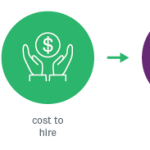HR is the skeleton of business: it’s the only discipline that touches every single part of a company, and without it, the whole thing crumples. HR pros need to know what matters to software engineers in an office space, how to attract superstar marketers, and what millennials are going to make of their work from home policy (to name a few). You need to understand the goals and motivations for both internal stakeholders and the general talent market.
Human resources folks are supposed to be able to understand and support… everyone. Needless to say, that task is close to impossible. When you have so much on your plate, it’s tempting to want to spring into action, but rushing into initiatives and trusting your gut blindly can be ineffective and even alienate your employees.
To be successful in human resources, you need to be in constant conversation with current, future, and even departing employees. That starts with listening.
Our comprehensive new playbook—Employee feedback for the win—explains how gathering feedback at every stage of the employee lifecycle can help you meet your goals, and gives detailed instructions for using surveys during recruitment, onboarding, development, retention, and offboarding. Here’s a sneak peek.
Want to engage employees throughout their experience?
Our comprehensive HR playbook explains how to use surveys to attract, engage, and retain talent.
How surveys can help you attract top talent
Recruiting is the area where human resources teams are most under the microscope, when it comes to metrics. You’re evaluated by the number of people you hire, the cost to hire, the amount of time that it takes to fill a position, and the offer acceptance rate. With so much pressure to attract talent early and keep candidates committed, it’s tempting to dive headfirst into outreach, but having data in advance hugely increases your chances of success.

Asking candidates about their hiring experience will help you understand which parts of your recruiting process are the most effective. Were any steps of the application process confusing? Were the job descriptions clear? Getting clarity early on makes for more fruitful interactions down the line.
Surveys can also help you get to know each candidate more intimately, and get background that will help you personalize your interaction with them. Surveys help you make sure candidates are really a fit for that role you’re trying to fill and that they’re getting the information they need to decide whether to pursue the opportunity.
Once you’ve found an awesome candidate and gotten that offer letter signed, take a moment to celebrate—and then go back to listening. Onboarding is your opportunity to get feedback about your recruiting process and set new employees off on the right foot. Do they have the information that they need to be successful? Are there details that might be important for future recruits? Keeping the feedback loop open means you’re able to keep evolving.
Stuck? Check out our recruitment survey template.
How the guide can help you meet your HR goals:
- Learn how to build a better employee experience by collecting feedback at each stage of the employee lifecycle
- Improve your surveys with best practices from our in-house experts
- Get started quickly with access to our library of HR-specific survey templates
As a recruiter, you’re under constant pressure to “convince” candidates to work for your company, but at the end of the day, your main job is to understand them. If you want to know whether your programs are working, don’t be afraid to ask!
Want to build a more inclusive employee experience from beginning to end?
Our comprehensive HR playbook explains how to use surveys to attract, engage, and retain talent.



